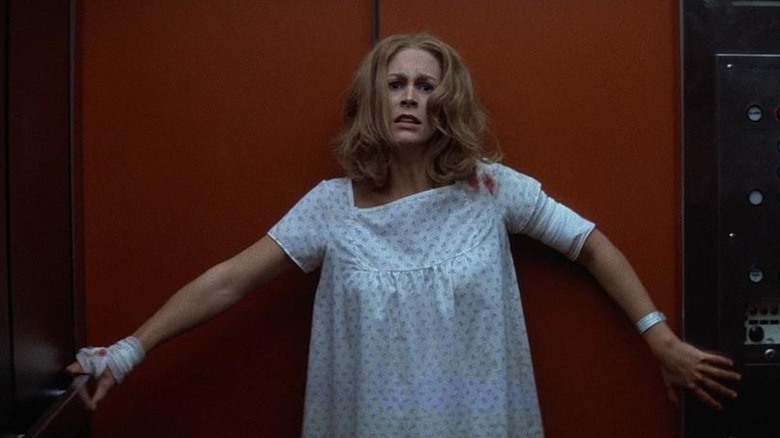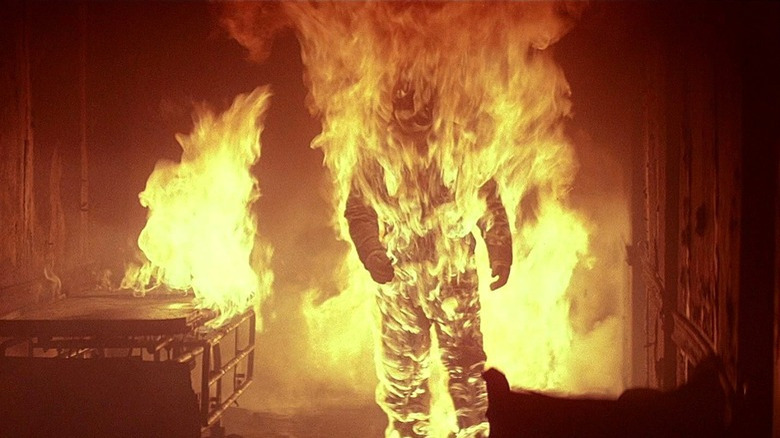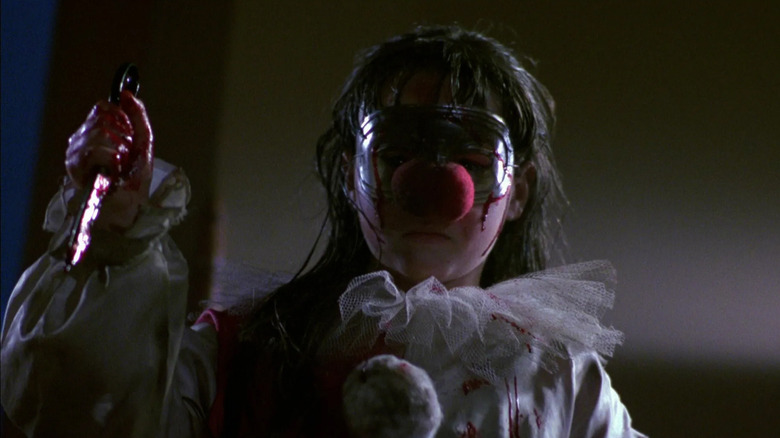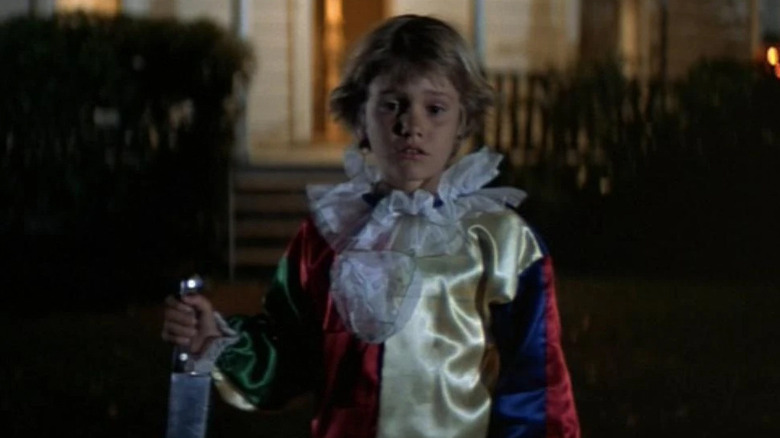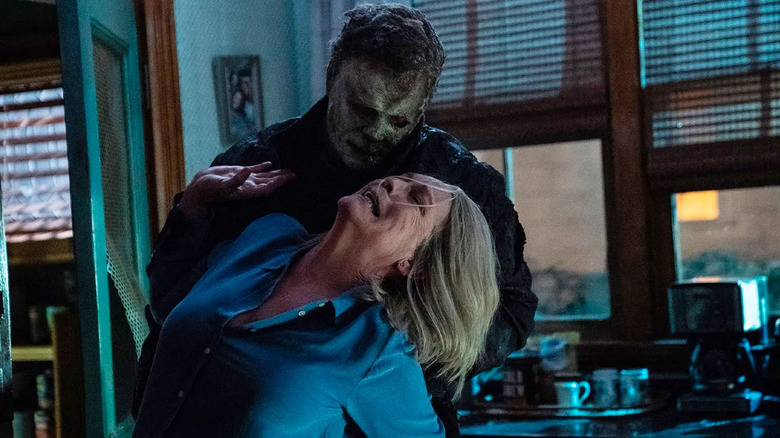Why We Never Saw These Bizarre Halloween Sequels
We may receive a commission on purchases made from links.
To the uninitiated, the "Halloween" franchise is just a slasher series. If you've seen one, you've seen them all. A masked maniac with a big knife wandering around different settings, cutting down anyone unfortunate enough to get in their way. Sure, while that might be true for John Carpenter's classic original, the series would grow increasingly odd and incredulous as the years went on.
As of this writing, there are four different "Halloween" timelines featuring Michael Myers. It starts with the original timeline, including the orignal "Halloween" from 1978, its sequel "Halloween II," the legacy sequel "Halloween H20," and "Halloween: Resurrection." Then, of course, is the colloquial Cult of Thorn timeline, which also includes those first two movies, followed by then "Halloween 4: The Return of Michael Myers," "Halloween 5: The Revenge of Michael Myers," and "Halloween: The Curse of Michael Myers." There's also the remake timeline courtesy of Rob Zombie, and more recently, there's the retconned David Gordon Green trilogy that kicked off with "Halloween" in 2018, picking up 40 years after Carpenter's original and ignoning all of the other sequels.
Whew! That's a lot of "Halloween." Even better, it's a lot of weird "Halloween." Stylistically and thematically, no two timelines are the same. As the franchise would develop and key creatives Carpenter and the late Moustapha Akkad (and later his son, Malek Akkad) iterated upon a successful formula, "Halloween" would come to mean many different things to many different people. The 13 movies we have are strange enough, but between their development, the franchise could have gotten even stranger.
Here, we'll be looking at some of the most bizarre sequel pitches from the franchise's storied history, going behind the scenes to determine why these "Halloween" movies never made it off the ground.
Halloween II: High-rise horror
"Halloween" was a massive success. As the burgeoning independent film movement in the late 1970s generated more attention and credibility, Carpenter struck gold. In retrospect, his "Halloween" is deceptively simple, yet there's a reason it endures as one of the scariest movies ever made. There's no beating the boogeyman, so naturally, the powers that be needed to bring the masked Myers back for one more scare. There was too much money on the line not to. What we got, of course, was Rick Rosenthal's safe yet effective direct sequel set in Haddonfield Memorial Hospital. It was as conventional as a butcher knife, picking up right where the original left off for more slashing, complete with an incredulous familial twist that would constrain the franchise for years.
But in the early stages, according to Bloody Disgusting, Carpenter and co-writer Debra Hill had conceived an idea that would see final girl extraordinaire Laurie Strode transplanted to a high-rise apartment building. Little is known beyond the core concept, though there's a chance the film would have gone full "Poltergeist III." The 1980s sure loved their high-rises. Carpenter would riff on the concept in his made-for-television movie "Someone is Watching Me," though as a footnote in "Halloween's" early history, it's fascinating to consider how the franchise might be different today had this early iteration taken off.
Halloween 4: The Boogeyman Version with a 12-foot tall Michael Myers
The real, wild "Halloween" sequels wouldn't start until Moustapha Akkad (and general audiences) would demand a franchise reset. "Halloween III: Season of the Witch" is a fantastic movie, and even as an avowed fan, I still have to concede it was unwise to release it as a "Halloween" sequel without Myers. So Myers needed to come back after seven years away. We got "Halloween 4: The Return of Michael Myers," an aptly-titled slasher that killed Laurie Strode off-screen and pivoted the focus to her orphaned daughter, Jamie (franchise mainstay Danielle Harris). However, far more interesting is the abandoned Dennis Etchison draft for Myers' return.
Tommy Doyle and Lindsay Wallace from Carpenter's original would have returned, living in a Haddonfield and still reeling from Myers' rampage a decade prior. Considerably more supernatural, Michael would conceptually be the boogeyman here, swaggering through town more as a phantom than a man. He would massacre drive-in attendees, somehow grow 12-feet tall at one point, and burn up in an unexplained inferno at the end.
According to "Taking the Shape II," Carpenter himself was a fan, calling it "an excellent script" (p. 36). Moustapha Akkad killed production, however, worrying the more supernatural approach was the wrong direction to take the franchise (nevermind that, by the actual "Halloween 5," the series had gone full-tilt supernatural). Sadly, audiences will never get to see Myers rampaging like a Kaiju.
Halloween 5: The Killer Inside Me kept Jamie evil
In the end of "Halloween 4," Michael Myers is ostensibly killed by a firing squad and dumped down a shaft. Then, Jamie Lloyd dons a clown mask, like her uncle years before, and attacks her foster mother with a pair of scissors. The idea is an interesting one, an augur for what David Gordon Green would attempt again in the recent "Halloween Ends." Michael's evil would be treated as a disease capable of infecting those around him. Even with his physical form dead, he could continue to kill.
According to "Taking the Shape II," both movie theater chains and Moustapha Akkad adamantly insisted the thread be dropped for the sequel. Jamie couldn't be a killer. Naturally, that meant Michael Jacobs' script "Halloween 5: The Killer Inside Me" was a no-go. Jacobs' idea had Jamie contending with evil doppelgangers of herself as Michael does what he does best. As a direct sequel to "Halloween 4," there's no breathing room, picking up right as that film ended.
In fairness, it's a lot, adopting the quasi-supernatural bent Akkad especially had been trying to avoid. Worse still, it's never clear where Jamie's burgeoning psychic powers (and delusions, including a knife-wielding social worker) were coming from. According to a Fangoria interview (per "Taking the Shape II"), "Halloween 5" director Dominique Othenin-Girard hated Jacobs' script, going so far as to throw it in the trash, all but ending the chance for a more sinister, evil Jamie (p. 104).
Halloween 666: The Origin involves ouija and virtual reality
If it isn't clear already, the Jamie Lloyd timeline was a mess behind the scenes. Everyone, at every stage of the process, wanted something different. For franchise fans like myself, that timeline yields plenty of charm, but even I must concede it's a tonal, narrative, and thematic mess. That hodgepodge of competing ideals came to a head with "Halloween 6: The Curse of Michael Myers," the feature co-starring a young Paul Rudd that would firmly kill the timeline, eventually leading to the first soft-reboot three years later with "Halloween H20."
Before the "Halloween 6" we got, which abandoned Danielle Harris as Jamie Lloyd, there was a sequel drafted by scribes Irving Belateche and Lawrence Guterman, USC Master's students commissioned by Bob Weinstein and given just 10 days to rewrite a much-hated draft from Phil Rosenberg according to "Taking the Shape II." Rosenberg's draft introduced new protagonist Dana, a reporter, and returning player Tommy Doyle (which would endure in the finished "Halloween 6").
The wildest beat involves a digital ouija board by means of virtual reality. Dana travels to an ancient Samhain festival where Michael's curse first appeared and gathers information on how to defeat him. It's truly mystifying. The revised script would scrap Rosenberg's name but retain some of wild elements, including virtual reality, but the rest was markedly different. As was common by this point, Akkad wasn't satisfied with either screenplay, bringing in Daniel Farrands for a script that better connected to "Halloween 5." Thus, a "Curse" was born.
Halloween 7: Two Faces of Evil kinda became Halloween H20
As wild as those previous two "Halloween 6" scripts sound, keep in mind the actual "Halloween 6" exists in two wildly different cuts, the theatrical release and a producer's cut. Neither are very good unless you're a diehard fan, and the tilt into Cult of Thorn terror would ultimately end the timeline for good. They're weird movies, the opposite of what Akkad wanted, so naturally, the need for more in the form of some kind of "Halloween 7" proved no less challenging than any sequel since the first.
Daniel Farrands' sequel idea expanded further on the Cult of the Thorn. According to "Taking the Shape II," his "Halloween 6" was pitched with a sequel in mind, though extensive rewrites rendered his proposed follow-up moot. Characters needed alive were now dead, and Laurie Strode was intended to return from the dead to save her daughter. Instead, Akkad wanted to move on — no more direct sequels — and hired Robert Zappia to take a crack at it. His school-set slasher has plenty of stellar set pieces, including a pool massacre, though is was planned as direct-to-video. There were no returning characters, no Haddonfield, and most importantly, a second killer entirely.
However, Jamie Lee Curtis wanted to return for the series' anniversary, and she would soon get involved, bringing with her new writers, including "Scream" scribe Kevin Williamson, new treatments, WGA arbitration, and a "Halloween H20" (seen above) that retains more of Zappia's ideas than we'd seen with past abandoned projects. For his efforts, Zappia was credited for both the story and screenplay.
Halloween H25 sounds better than Resurrection
Rick Rosenthal's (returning from "Halloween II") "Halloween: Resurrection" was a mess, and it's easily the worst film in the entire franchise. The series' development has aptly demonstrated how protective Moustapha Akkad was of his seminal slasher franchise which renders the existence of "Resurrection" all the more confounding. Among the myriad of absurd moments, Laurie Strode's death ranks chief among them.
According to "Taking the Shape II," Akkad had a clause that Michael Myers couldn't die. Yet, at the end of "H20," Myers is beheaded. Well, not so. Akkad and uncredited scribe Kevin Williamson concocted a harebrained scheme to have Michael body-swap with a paramedic, rendering the previous film's final moments moot. The remainder of "Resurrection," post-Strode, isn't much better.
However, "Taking the Shape II" outlines a planned sequel that would have at least delivered on what little digital promise was hidden within. Writer Tim Day developed a treatment, titled "Halloween H25," that would pick up where "Resurrection" ended. There would be high-tech prisons, a la 2013's "Escape Plan," a documentary crew covering the Dangertainment deaths of the previous film, and naturally, plenty of bloodshed. Day's treatment is committed to its gonzo excess, running with "Resurrection" where most past treatments endeavored to maneuver away from, not into, the confines of their predecessors. Would it have worked? Probably not, and a changing horror landscape replete with new slasher icons stopped the sequel dead in its tracks. Though it's fun to imagine what "Halloween" might have been had another timeline not been stopped in its tracks.
Michael Myers vs. Pinhead? Sure!
"Halloween: H25," had it been released, would have contended with several other high-profile slasher icons. According to "Taking the Shape II," Dimension (and Akkad) feared Myers couldn't hold his own, keeping him at bay until 2007's Rob Zombie remake. At the time, Leatherface was the talk of the town thanks to Platinum Dune's "The Texas Chainsaw Massacre" remake, and both Freddy Krueger and Jason Voorhees had successfully squared off in "Freddy vs. Jason." But could Michael have had an adversary of his own? For a beat, yes, with the planned development of a feature film pitting Myers against Pinhead of the "Hellrasier" series.
Rumblings existed for years, though it was Freddy and Jason's success that imbued the project with serious financial merit. There was money to be had in combining two horror icons, and writers Josh Stolberg and Bobby Florsheim stepped in to deliver. Their pitch saw characters from both series, principally Jamie and Kirsty, attending a support group for slasher survivors. Grady Hendrix would play with the concept in his novel "The Final Girl Support Group." Basically, Michael kills Kirsty, incurring the wrath of Pinhead and his fellow cenobites. While Carpenter and Clive Barker were both on board, Moustapha Akkad feared diluting Michael's brand, stepping in as a protective parent. Really, he didn't want Michael hanging around with the likes of Pinhead.
Halloween 3D would have given Rob Zombie a trilogy
The next "Halloween" fans would get post-"Resurrection" were Rob Zombie's hillbilly-core remakes. I use that phrase endearingly, as does Zombie, since his "Halloween II" features a track titled "Honky Tonk Halloween." They're not masterpieces, but they were the freshest thing Michael Myers had been permitted to do in over a decade.
According to "Taking the Shape II", the shoots were tough, and Zombie had been adamant that he had no intention of returning for a sequel to his remakes. The Weinsteins, however, wanted it desperately. Love them or hate them, Zombie's movies made slasher bank. Where there's a will (and money), there's a way. Todd Farmer and Patrick Lussier were contacted while "Halloween II" was still shooting. The studio wanted Michael to have a 3D outing. It was gnarly.
There was a conclusion planned for Laurie's new arc, a giant pumpkin concert, and a gruesome Myers mask melted into the preeminent killer's face. Visually, the pitch was sound, but financial woes resulted in the project languishing. In fact, both Farmer and Lussier found other work while waiting for it to happen, and in a few short years, the Weinsteins would lose the rights to the franchise entirely. Zombie's "Halloween II" would be the last time they got to unleash Myers on the world.
The Platinum Dunes Halloween
In April of 2012, Bloody Disgusting announced that Platinum Dunes was working on a "Halloween" movie. It was swiftly canceled. Bloody Disgusting did share an animated pitch that illustrated what the new sequel would be going for, but the short-lived project, like so many before it, struggled to move forward before being canceled entirely. In the post-Zombie era, the studio really did try to get another "Halloween" off the ground, according to "Taking the Shape II," but they never could. It's a shame, since the Platinum Dunes remake, like the other horror remakes in the pantheon of their releases, sounded pretty sick.
Young Michael and another boy, Sean Carver, are kidnapped. Years later, coeds start getting knocked off in Haddonfield. Who's doing it? Not Michael, at least not at first. It's Sean Carver. Michael only appears after a climactic ferry battle in the final reel. He's there to kill his older sister, Judith, now alive in this rebooted timeline. The general thrust of Scott Milam's pitch retained the thematic nature of "Halloween" while breaking with narrative tradition. Like Zombie's films, it would reboot the timeline, subverting expectations with a final wallop that left the door open for possible sequels. It was inspired by "Halloween," not beholden to it. Dimension executives, inundated with scripts, couldn't make a decision. There were so many possibilities, though they opted not to move ahead with any of them. It really was that simple.
Halloween Returns
Way back in 1981, Nurse Karen Bailey (Pamela Susan Shoop) was late to work in Rick Rosenthal's "Halloween II." Her friend asks for a ride home, though Karen, not wanting to be late, suggests she ask Eddie Lee. "He's in Russellville," the friend replies. "Halloween Returns," had it been made in 2015, might well have been Eddie Lee's neighbor. It was also in Russellville. The planned sequel, with Patrick Melton and Marcus Dunstan of later "Saw" fame attached, would have canonically scrapped the sequels post "Halloween," picking up where that first movie left off.
Michael is set to be executed, though he naturally escapes and embarks upon a Russellville-set killing spree. An entirely new ensemble would be introduced, with Dunstan, in an interview with Shane Poole and Darnell Weeks, remarking that his sequel would be the "Aliens" equivalent in the "Halloween" universe. There was plenty of fire, a burgeoning scale, and a recommitment to the idea that Myers' evil transcends human comprehension. Its fate will shock no one. Dimension, par for the course by this point, couldn't commit, despite an official announcement in Variety about the production. In December of that year, the lapse in regular releases resulted in Dimension losing the rights for good.
The future of the franchise now
The most recent cinematic iteration of Michael Myers ended with David Gordon Green's polarizing, though aptly titled "Halloween Ends." Ostensibly (though this has been the case three times now), it finally put the Laurie Strode saga to rest. Granted, Michael Myers is eviscerated in an industrial grinder at that film's conclusion, so his odds of coming back canonically are slim. But let's not forget that early iterations of "Halloween 4" had Michael growing 12-feet tall, so who's to really say?
In October 2023, one year after Green's trilogy concluded, Miramax won a bidding war for the television rights, adding another notch to their longstanding history with franchise rights holder Trancas International Films. Miramax envisions a cinematic universe for the series that spans both cinema and television, all but guaranteeing Michael won't stay dead long.
For now, Miramax and Trancas retain full "Halloween" rights. Their full plan remains under wraps, though while there was speculation that the series might be heading in a new direction, the news strongly suggests more of the same. So no battles with Pinhead, no evil Jamie Lloyds, and no high-rise terror. Those scares, fascinating as they are, will remain footnotes on a page, curious wrinkles in a mask that has endured for almost 50 years.

